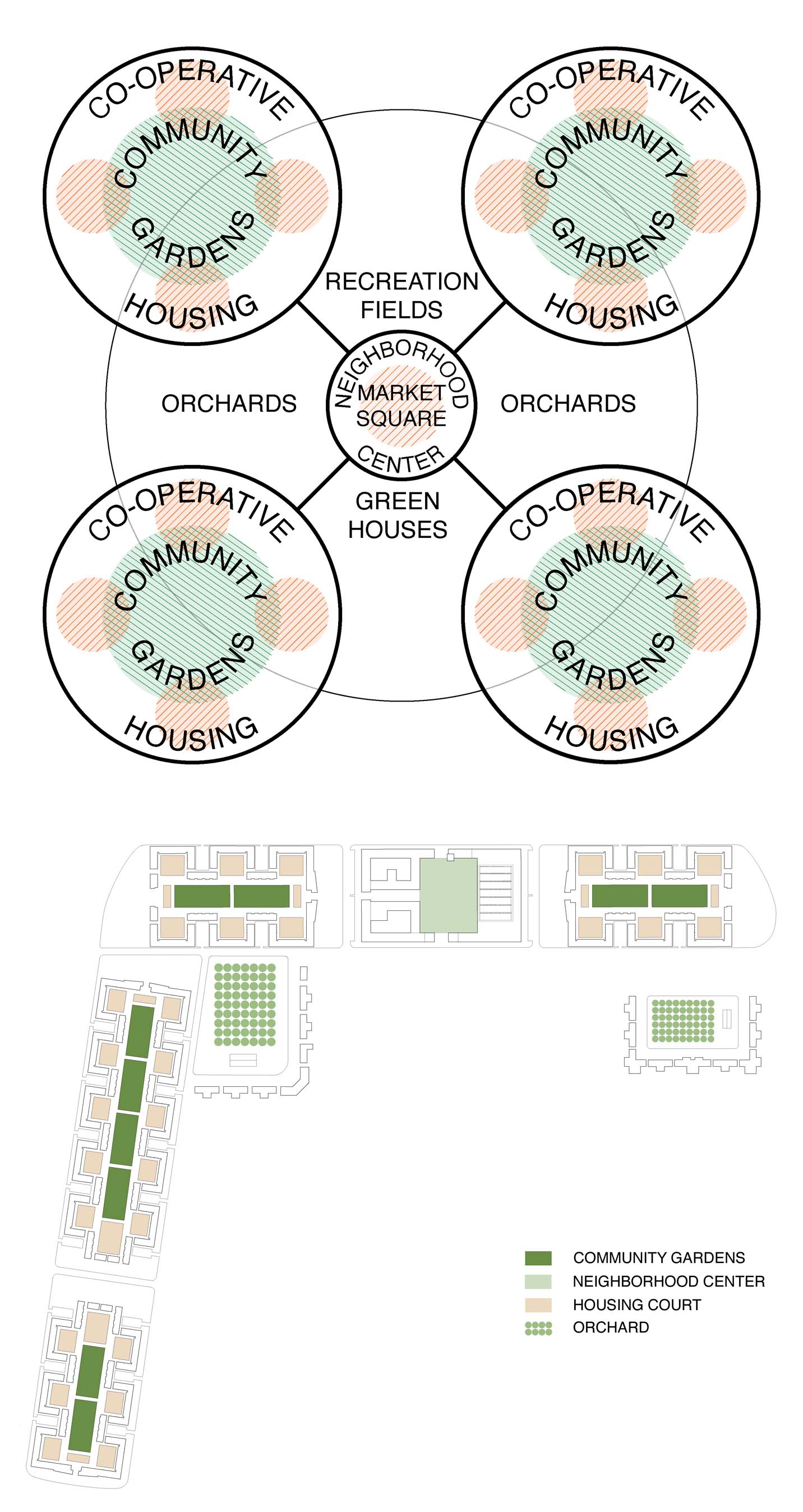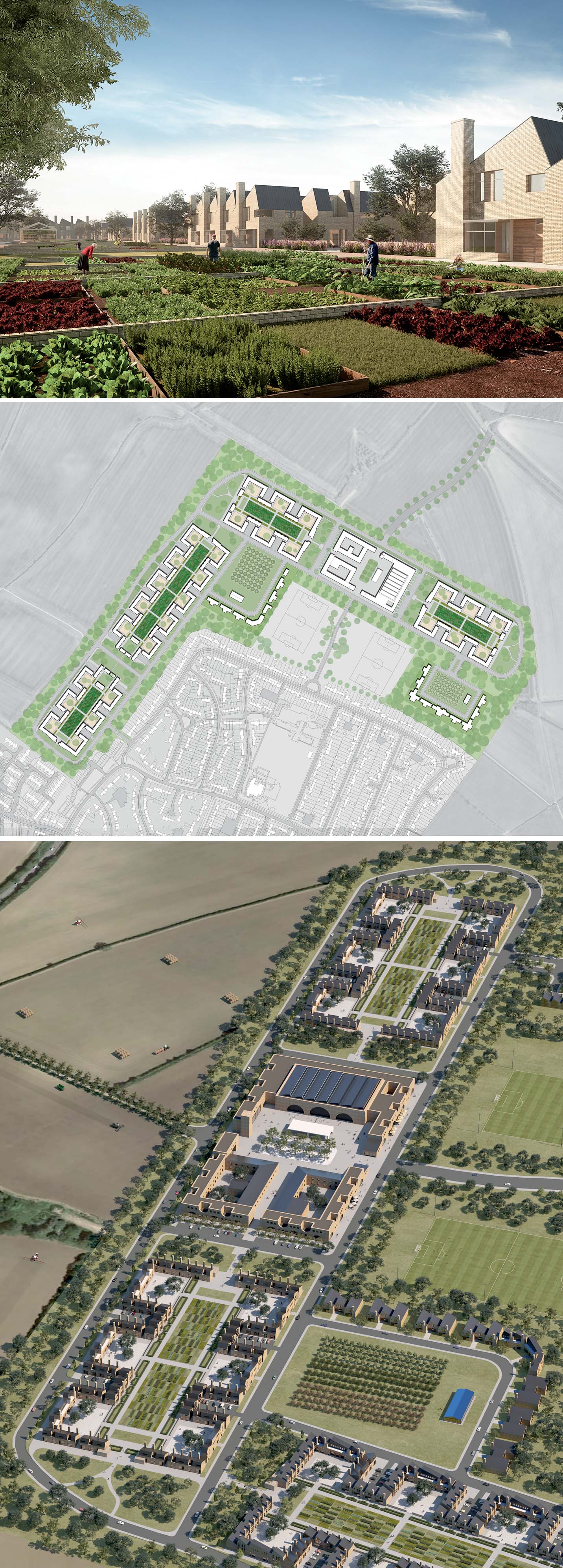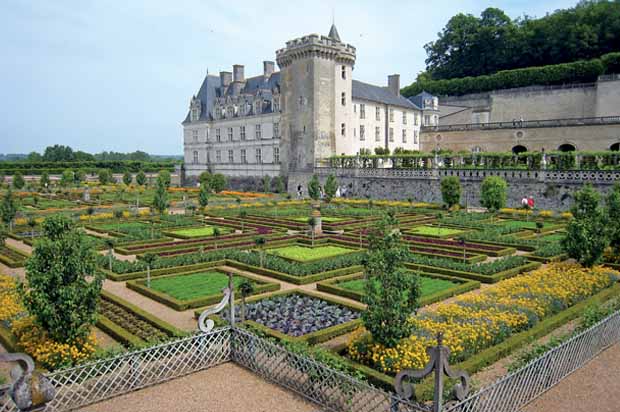It’s clear that there needs to be a rebalancing of the relationship of food production with our cities. It is a question not just of the liveability of our cities, but their viability, as well as the health of our bodies and the planet as a whole. The health of our population and of our cities are connected. This article looks at the essential role that architecture and urbanism can play in achieving this balance. Traditional cities have historically had a more nuanced and scaled means of growing food regionally and distributing food locally. Such a relationship created more sustainable regions with localised agriculture and contributed to a sense of place through distribution (markets) and consumption of food (cafes, restaurants). Although such relationships have been disrupted since the times of industrialisation and the advent of modern urbanism, there are recent signs of resistance within the discourse and actions of scholars, planners, farmers and citizen activists. These are complex and interrelated problems, not siloed issues to be solved by respective experts. Architecture and urban design are uniquely positioned as a profession to help bridge specialties to contribute to broader solutions.
This article focuses primarily on the food production part of an agrarian network and ways to accommodate new urban spaces for growing food in neighbourhoods. In the past few decades, people have been more interested in growing their own food as well as understanding the health implications of organic, local farming. Architects and planners can help design the means of re-introducing food growing in cities; specifically designing new relationships between food production spaces and housing in neighbourhoods. Students of urban planning history will of course know that Ebenezer Howard addressed these concerns in his Garden Cities of To-morrow – his theoretical attempt at harnessing the otherwise destructive powers of the inexorably industrialising world. Here, I will attempt to use some of these foundational ideas for the Garden City in an updated way that integrates food production at a more local scale.

Middle : Plan of Radburn, New Jersey, by Clarence Stein. Stein invented the American superblock, two of which form the large development of Radburn. This allowed the interior of the blocks to be dedicated as a natural park-like setting, while cars were kept to the perimeter
Bottom : Otto Wagner, Die Grosstadt (1911). Wagner was experimenting with the relationship of urban to architectural form in the modern city. He employed perimeter block buildings to define interior courts, as well as to create voids in the city for nature and social gatherings. Other European architects at this time exploring block-based urbanism were Eliel Saarinen and Hendrik Berlage, amongst others
What is the food problem and is it only about food?
Most of us have become further removed from the sources of our food. This has occurred for two primary reasons: the growth of global industrialised agriculture and the urban form of post-war sprawl development. These are not unrelated phenomena and both contribute significantly to climate change and global warming.
The majority of our crops are now produced by large agricultural businesses for global distribution and consumption. A great portion of our daily ‘food’ consists of unhealthy processed and manufactured products, about which Michael Pollan has so eloquently written. Food distribution in the last half-century has relied less on local markets and more on large retail supermarkets, owned by public corporations and distributed by the very global supply chains that might oversee the logistics of clothes or tires or computer parts. The industrialisation of food manufacturing and distribution has left many parts of our world and cities vulnerable to the fluctuations of global market prices and supply and created ‘food deserts’ where people cannot find basic, healthy food, let alone grow what they need.
At the same time, we must realise that there is a crisis in housing and its patterns of development, which began with reactions to the historic increase of urban populations at the beginning of industrialisation, but has been exacerbated by decades of post-war sprawl development. Such urban form is based on the car, connecting zones of single-use urban conglomerations with highways. Food is manufactured afar, shipped to an urban region, distributed to supermarkets, which are accessed by residents by car. That is a highly inefficient, wasteful system, with severe environmental impacts.
Urban and suburban development in the post-war decades have seen the creation of housing with limited exploration of architectural typology and limited contributions to a larger urban pattern. Most housing today is either single-family housing on isolated lots or large multi-family buildings with little sense of context or integration with its surrounding urban space. Both are equally separated from food production, distribution and consumption. Further exacerbating the economic health of many countries is the fact that housing has become more of a commodity than a stable home, with mortgages bought and sold like any other traded products. While a possible source of personal equity in the best of times, home ownership is even riskier now, and we have seen this past decade the crisis caused by these certificates of ownership becoming detached from their residents and bundled into convoluted global financial packages. So, besides the need to explore typologies of housing, there is also a need to explore different modes of home ownership. Indeed, Howard proposed a new economic system as an inherent part of his Garden City proposal.
Most of us have become further removed from the sources of our food
Reframing the problem
With the issues of climate change, food deserts and the vast restructuring of urban, suburban and rural space from post-war sprawl, many planners and environmental activists are looking at ways to reintroduce a productive landscape into urban areas. It is becoming clear that a healthy and sustainable city must incorporate regional and local food production. Furthermore, there is a growing demand by people for such local farming, even for leisure and personal health reasons. Such integration does not mean that all farming must be located within a city, but that there should be options to incorporate farming in cities and connected to people’s everyday lives.
But this means that the way our cities have been structured must change. Our typical post-war cities, towns and suburbs are not spatially equipped for food production, especially as a positive, socially cohesive space. Open spaces in contemporary cities, especially with modernism and zoning, are often more residual than positive and figural, let alone productive. The low-density form of sprawl development and zoning is inefficient and wasteful. The dependence on driving in suburbia further exacerbates the climate crisis and reinforces our dependence on oil. Ironically, Anglo-American suburbia in particular had been developed with the symbolic pretenses of Arcadian nature and leisure. Yet in most suburban areas, the front and back yards are not intended to be productive, to be visible as a food garden, but rather emphasise a place for the culture of consumption and leisure.
Recently, the approach to spatially accommodating the food growing needs of cities has been discussed extensively by planners, academics, environmentalists, landscape theorists, etc. at two opposite scales. One scale, the regional and urban, discusses how to introduce farming at that large scale, either through setting aside large single-use zones of communal farming, like allotment gardens, preserving green belts, or the current notion of continuous productive urban landscapes (CPULs). At the opposite, smaller and more tactical scale, there have been proposals for occupying incidental and leftover spaces of the city, such as rooftops, exterior walls, empty lots and front yards.
What is missing is a coherent ‘architectural’ discussion at the middle scale of the design of urban housing. Gardens and open spaces have, in the past, been part and parcel of designing places, of being seen as positive voids defined by buildings. This open space has been used in many ways depending on cultural needs and on the urban planning visions of the day. Sometimes it is recreational space, sometimes simply ‘green space’ and gardens. Rarely has the notion of defined urban open space in the past century focused on productive landscape and food.

Bottom : Open Space diagram of Dutton Architect’s Garden Housing
How was it solved in the past?
Most traditional cities in history had to rely on regional agriculture for their existence, and accommodated those needs within or just outside city boundaries. While burgeoning realms like the Roman Empire were able to create complex trade and distribution networks for certain foods and goods, most towns relied on local food that through time has proven to be appropriate to that region’s climate and soil. Medieval Paris used what is now the Marais (which translates as ‘swamp’) to grow its food supplies before being filled in for urban expansion. Pre-industrial villages were often clustered amongst agricultural fields (an arrangement that is also consistent with neo-traditional practices advocated today by Andres Duany in his Agrarian Urbanism). Historically, many houses were walled and contained gardens. This was evident in houses as early as even Etruscan and Greek eras, as well as common in Roman villas. In the 16th century, kitchen gardens were common, and many courts and castles were designed with walled gardens within their fortified domains; Villandry (a chatueau in the Loire Valley of France) perhaps being the most famous today.
It’s clear that a healthy and sustainable city must incorporate regional and local food production
There is a long history of allotment gardens too, where communities set aside shared space outside their own domain of housing. While significant as a place for residents to grow their own food, they are typically external to any urban framework and therefore usually not integrated into urban form. Allotments were originally used by the working class to augment their food supply. Many immigrants would use allotments as a way of growing fruit and vegetables from their country of origin that were otherwise not available in their new place. Sometimes allotments were used for national emergencies, such as the need to provide food during the disruption of war. After the USSR collapsed and pulled its financial support and agricultural subsidies to Cuba, a system of organic infill gardens (organopónicos) was developed by necessity. To this day they supply much of Cuba’s residents and are a model for community organic farmers the world over.

Middle : Site Plan of Dutton Architect’s Garden Housing. Housing courts surround community farming, creating farming clusters that aggregate around a neighbourhood centre with stores, market hall and central plaza
Bottom : Aerial View of Dutton Architect’s Garden Housing on the outskirts of Unwin and Parker’s Letchworth, one of the first garden cities. Dutton Architects’ plan takes those original principles and modernises them, while incorporating productive food gardens
Architectural means of integrating housing and gardens
Although architectural and urban design discourse have rarely focused on growing food, there have been exceptions. Ebenezer Howard’s vision for a constellation of semi-autonomous towns surrounded by industry and agriculture, and owned by the community, was published in 1902 as Garden Cities of To-morrow. His proposal sought to integrate Country and City, and spurred a movement for garden cities all over the world. The reality, not surprisingly, was that the form of these garden cities could not match the diagrammatic clarity of Howard’s principles.
At the same time, there was a wealth of exploration at the intersection of architecture (especially housing) and urban design, right up until the ascendancy of CIAM, the modernism movement. Architects Otto Wagner, Hendrik Berlage, Eliel Saarinen, Raymond Unwin, for example, and some State-supported housing programmes like ‘Red Vienna’, indicated new ways of integrating housing form into cities with the interplay of open space and architecture, using varied urban block patterns and the creative application of ‘perimeter block’ typologies.
In the post-war U.S., architects such as Clarence Stein designed the Village Green in Los Angeles, Sunnyside Gardens in Queens, NY, and Radburn in New Jersey, which created superblocks of housing (and some mixed-use) with the interiors left as open space. Superblocks are not the best universal model for urban development, as the vast scale of the blocks undermines pedestrian scale in the city, and their inward focus, while providing respite from urban activity and a change of focus, would not in aggregation create urbanity.
Could the varying scales of open spaces created by this urban architecture be a place for food growing at this middle scale? These large semi-public open spaces have been defined in the past as recreational space, playgrounds, parks, schools and markets; so why not agricultural spaces, particularly for residents dedicated to gardening? Instead of gardens being outside the architectural definition, as part of the vast field of space in which sit modernist towers and slabs, could these superblocks give us tools to have an architecture of the city that creates community and provides ample space for growing food?
Such semi-public spaces, defined by the housing described above, are thresholds between public space and private space and provide a middle scale of design that has been largely overlooked (with the exception in recent decades of more traditional designers in Europe or the New Urbanists in the U.S.) and is ripe for investigation. At the right scale, defined architecturally, they could create productive open space of farming. Combined with the co-operative model of housing, or community land trusts, such a prototype could point to new ways of creating affordable housing for a community that wants to be involved with gardens and food growing. It could even be scaled up in aggregation to the level of a neighbourhood, producing food for the residents helping to foster a more convivial, healthy and resilient city.
The neighbourhood centre helps foster the conviviality of an urban community by providing other parts of food culture
A productive garden city
A hypothetical example of such housing design focused on food growing was developed by our office, Dutton Architects, on the outskirts of Letchworth, the original Garden City designed by Unwin and Parker in 1905. In this proposed neighbourhood, there is a gradient of scale, from the housing unit all the way to the neighbourhood itself, with the primary middle scale consisting of a cluster of courtyard housing buildings arrayed around a long community garden. These clusters vary in size and shape and themselves are arrayed around a neighbourhood centre, which contains stores, cafes, a market hall and an open plaza. The neighbourhood centre helps foster the conviviality of an urban community by providing other parts of food culture such as produce markets, cafes, pubs and restaurants.
The housing is situated around courts, semi-private open spaces and is comprised of different typologies; single-family town houses face the community garden, multi-unit shared apartments are on the side of the court and co-housing anchors the rear of the court. The shared common facilities and governance of the co-housing reflects the larger cooperative housing that would govern the agricultural-based community as a whole. The varying typologies of housing would provide accommodation for people at different places in their lives, with different family situations. Besides the large community gardens at the centre of the clusters, there would be land set aside for orchards, as well as productive street trees. Room for large greenhouses would be provided throughout the development as needed. In this way, it is hoped that spaces used for the growth (sale and consumption) of food can be integrated into neighbourhood design.
How we grow our food and what we eat is becoming the focus for many of the world’s urban denizens, for both recreational and health reasons, and can be seen as a reaction to decades of industrialised farming. Regional municipalities are also looking to integrate, in a more self-sustainable way, agriculture and cities. It is clear that such local growing will contribute to the increased health of a city and its people. There is a role for architecture to promote such goals through the shaping of urban spaces that could accommodate this small-scale agriculture. Especially if tied to housing typologies, there could be new clusters of communities focused on small-scale farming, integrating housing, open spaces, and gardens as an essential part of healthy, walkable and vital cities.
All Image Source: Dutton Architects



Comments (0)